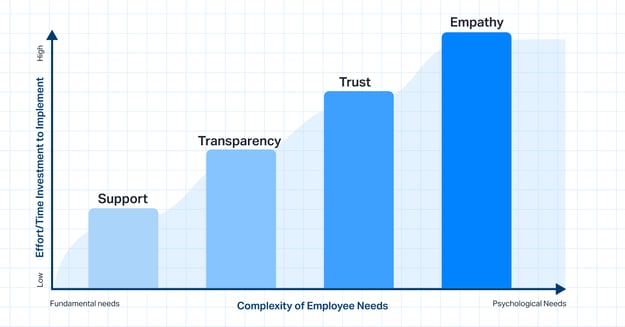
Technology is critical to enhance employee experiences and productivity. Today's HR leaders must deliver customized experiences based on support, transparency, trust, and employee empathy. These can be enabled with the right tech tools that can assist in creating personalized experiences, fostering a diverse workforce, and improving employee efficiency.
As the technological, generational, and social shifts influence the world of work, the imperative for organizations to invest in employees has never been higher. The unique growth strategy of organizations focused not just on margins but also on productivity and sustainability makes it even more critical for business success. Organizations must enable employees to stay productive and deliver value by providing the right experience.
With this business need, HR is in the spotlight again. According to Darwinbox's HR Perspectives 2023 report, 68% of organizations expect HR leaders to enhance employees' experience to achieve business and talent outcomes.
Enabling Employees to Deliver Value Through Right Experiences
Employee enablement equips employees with the right tools and skills to excel. In the rapidly changing business and talent landscape, organizations must enable employees with the right experiences. Employee experience is nothing but employees’ perception of their journey through all the organizational touchpoints.
Our research also suggests four critical pillars to delivering the right experience to employees – supporting them, being transparent with them, building mutual trust, and showing empathy. Giving employees the right experience at the right pace in the correct order on these four pillars enables them to deliver increased value for their organization’s growth.
Figure 1 – Pillar to Enable Employees – Complexity vs. Time/Effort Matrix
- Support: Assist employees when, where, and how they need it and empower them to support themselves.
- Transparency: Equip employees to access their personal and relevant organizational data, provide them with the information to succeed in their current roles and advance their aspirations, equip them with timely information, and help them make relevant choices.
- Trust: Use employees’ data ethically, establish a relationship of honest communication with employees, provide them with the autonomy to accomplish work, and value their opinions and perspectives.
- Empathy: Tailor initiatives for employees based on what is important for them in their unique contexts enable them to bring their authentic selves to work and feel valued.
Challenges HR Leaders Face in Delivering Employee Experience
While employee experience is how employees perceive their journey in the organization, employee engagement is an outcome. Most HR leaders understand the need to provide positive experiences to enable and empower employees. However, they fail to deliver successfully, leading to employee disengagement and attrition.
With global disruptions and changing dynamics in managing talent and work, such as multi-generational workforce, hybrid ways of working, technology replacing repetitive jobs, emerging skills and capability development needs, the expectations of businesses and employees are evolving. On top of that, different employee groups have different needs, motivations, and expectations. HR leaders find it challenging to deliver an experience that caters to all employee segments and aligns well with business goals. Hence, the one-size-fits-all approach to providing experience does not work.
We recently surveyed over 1,500 employees spanning five different generations about their organizations’ delivery on key experience parameters. It shows one of the lowest-scored experiences highlighted by all the employees in different generations is the tailored digital experience per their role and demography. Organizations must personalize, not generalize, the employee experience to enable a diverse workforce, and technology plays a critical role in it.
Leveraging Technology to Create High-Tech, High-Touch Experiences
The organizations’ priority to enable employees to deliver value is evident in how technology is evolving today. With the wave of AI transformation, HR technology is at the tipping point of innovation. The increasing significance of leveraging HR technology is not just to improve HR agility and efficiency, but also to enable employees to be more productive and elevate their experience.
Here are some of the ways organizations can leverage technology to create not just high-tech but also high-touch, personalized experiences:
Support
Use unified, easy-to-use, self-service HR delivery platforms and chatbots for efficiency in compliance and query resolution
Case example – A rapidly growing Indian Small Finance Company deployed chatbots in partnership with Darwinbox to provide real-time employee support. The solution provides the workforce with quick access to information about leave balance and status, payroll, referrals, helpdesk tickets, and customized Q&A. The chatbot offers a native web application, a voice Bot in the mobile application, and a chat feature in the Darwinbox application for Microsoft Teams. It promotes self-service with intelligent intents and logical processing for improved outcomes, allowing the company to create custom intents and queries and assign customized responses for user groups. Managers can also provide approvals through the chatbot. Making the employees self-reliant was the solution that helped the core HR team members save over 25% of their time, unlocking their potential to contribute to value-adding activities.
Reward performance, efforts, and contributions, and discuss various career paths for growth and learning
Case example – A global chemical manufacturer was stuck with an outdated employee recognition process. They wanted something more modern and engaging, a system that could boost employee development, team spirit, and acknowledge the stars of the show. Enter Darwinbox. With its sleek SaaS solution, it transformed the way employees were recognized. Now, there were gamified badges, leaderboards, peer shout-outs, a rewards marketplace, nomination rewards, and event-based prizes—a total game changer. In just a year, the impact was clear. Employee recognition shot up - 177 employees were recognized, and an impressive 529 took the time to recognize their colleagues. Now, that's what you call team spirit!
Create a digital onboarding experience to equip new employees with the organization’s culture, norms, processes, and tools in a more streamlined manner
Case example – A major Indian Pharma company struggled with a prolonged onboarding process that lasted as much as ten days. This created a negative new-hire experience, and the company partnered with Darwinbox to turn around the new-hire onboarding experience. The Darwinbox solution allowed easy updates to candidate details and all document collection on the date of joining itself. With this solution, the company could reduce its onboarding time from ten to just three days.
Transparency
Provide visibility to relevant organizational data with the right checks and balances
Case example – In response to the client's need for diverse and customizable reports to analyze employee data, a solution was devised. Leveraging Google Data Studio and Darwinbox reports builder, the client embraced pre-set templates and formulas, automating the generation of reports. This streamlined reporting process saved valuable time and facilitated quick visualization of crucial HR metrics. The impact was significant—empowering the client with a data-driven approach to decision-making for enhanced HR management. Now armed with efficient tools, the monthly management review is more insightful, offering a comprehensive understanding of demographics, employment details, and attrition within the organization.
Create career pathing plans tailored to employees’ goals and aspirations to build transparency in employees’ growth and professional development opportunities
Case example – A large Indian Retailer struggled with non-transparent career frameworks, limited transparent talent data, and time-consuming knowledge delivery and assessments requiring frequent follow-ups. Its employee skills assessment was also ad hoc and heavily depended on the reporting manager. The retailer used a combination of Darwinbox’s HRMS capabilities and Disprz’s LMS to democratize career and skill development for its workforce. This allowed a holistic view of talent and learning development with a learn-from-anywhere mobile experience. The outcome of this implementation helped the retailer arrest attrition early and accelerated career programs by 33%. This transformation today empowers its undergraduate workforce in tier 2 and 3 cities to rise from being cashiers or fruit stackers to managerial roles.
Trust
Use collaboration tools for open, honest, and real-time conversations while keeping a multi-channel communication strategy for an improved digital experience
Case example – A Telecom company based out of Indonesia wanted an active channel for employee engagement and communication to drive cross-organization collaboration and enhance employee experience. The company deployed Darwinbox’s Enterprise Social Network, Vibe. Within the first four months of deployment, the platform became a thriving hotspot of engagement for all its workforce. It had five working groups, four groups catering to hobbies and interests. There were about 5,000 posts, with an average of 1,200 posts per month.
Create a tech-enabled ecosystem to provide a safe and harassment-free workplace
Case example – A leading Indian bank struggled to track and tackle workplace violence and harassment. With the business booming, many of these incidents were sliding under the radar due to fear of backlash and reputation damage. The bank teamed up with Darwinbox to create a system that would make employees feel safe about reporting these issues. The new setup managed to keep things anonymous, set up an impartial regional panel for investigations, and even created a safe space for case discussions. This system isn't just for addressing violence and harassment; it's also being used to check out any resistance to the bank's DEI initiatives. The bank sees this as a way to boost psychological safety, making the workplace a better space for everyone.
Empathy
Use the Moments that Matter approach to listen to different employees and sense the unique moments that are important to them to curate tailored experiences
Case example – A fintech client saw that performance feedback needed to come from more than just the top. After all, a manager can't catch everything with today's team-based work. The introduction of the MSF (Multi-Stakeholder Feedback) tool was a game changer. Employees could now pick who they wanted feedback from, including their peers and external contacts. Naturally, this was subject to a manager's approval. Trust skyrocketed! By embracing the 'moments that matter' approach, feedback became more inclusive and comprehensive, giving a richer picture of employee performance.
While many organizations are planning to do so, and some progressive organizations are already using technology to enable people to deliver value, the work doesn’t end here. They need to ensure their employees adopt these technologies and utilize them effectively. Our research shows that only 41% of market average organizations agree their digital platforms have high adoption. Developing digital dexterity, creating awareness, and making these platforms easy to access and use are some of the critical ways to drive digital adoption.
Conclusion
HR leaders have a business imperative to develop a digitization strategy and embed it in their operations model. HR Technology is the catalyst HR leaders can leverage to deliver peak employee experience. This enables employees to deliver value via increased productivity, performance, and engagement and improves organizational outcomes.
Please read our latest research on HR Evolution Perspectives to gain insights on delivering employee experience successfully and understand the role technology plays in it and overall HR transformation.
To dive deeper into the insights and recommendations and how our platform helps you implement these, schedule a demo with Darwinbox experts.



Speak Your Mind